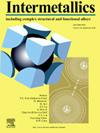Significant low-temperature conventional and inverse magnetocaloric effects in ErSb and HoSb compounds
IF 4.8
2区 材料科学
Q2 CHEMISTRY, PHYSICAL
引用次数: 0
Abstract
The low-temperature magnetocaloric (MC) effects in many rare-earth (RE)-dominated solid-state magnets were extensively studied in recent years to develop high-performance MC materials for magnetic cooling application and deepen clarifying their underlying magnetic characters. We herein synthesized two single-phased RE-dominated magnetic solids, namely the ErSb and HoSb compounds, by the induction-melting method and experimentally unveiled their structural and magnetic properties, specifically their magnetic phase transition and low-temperature MC properties. Both compounds crystallize in the NaCl-type cubic structure (Fm-3m space group) with a uniform microstructure and exhibit low-temperature antiferromagnetic (AFM) ordering at approximately 3.7 K and 5.5 K for the ErSb and HoSb compounds, respectively. Meanwhile, they exhibit significant low-temperature conventional and inverse low-temperature MC effects, attributed to their AFM ground state and unique, first-order field-induced magnetic phase transition (MPT). Moreover, we identified their conventional MC performance using the magnetic entropy change/temperature-averaged entropy change (5 K-lift) and refrigerant capacity, which are 20.8/19.2 J/kg·K and 214.3 J/kg for ErSb, and 22.3/21.5 J/kg·K and 256.6 J/kg for HoSb, respectively. These MC parameters of ErSb and HoSb are comparable to most known high-performance low-temperature RE-dominated MC materials, making them attractive candidates for practical cooling application.
ErSb和HoSb化合物中显著的低温常规和逆磁热效应
近年来,人们广泛研究了以稀土为主的固态磁体中的低温磁热效应,以开发用于磁冷却的高性能磁热材料,并进一步阐明其潜在的磁性特性。本文采用感应熔炼法合成了两种稀土为主的单相磁性固体ErSb和HoSb化合物,并通过实验揭示了它们的结构和磁性,特别是它们的磁相变和低温MC性能。两种化合物均以nacl型立方结构(Fm-3m空间群)结晶,具有均匀的微观结构,ErSb和HoSb化合物分别在约3.7 K和5.5 K下表现出低温反铁磁(AFM)有序。同时,由于它们的AFM基态和独特的一阶场致磁相变(MPT),它们表现出显著的低温常规和逆低温MC效应。此外,我们利用磁熵变/温度平均熵变(5k -lift)和制冷剂容量确定了它们的常规MC性能,ErSb的磁熵变/温度平均熵变分别为20.8/19.2 J/kg·K和214.3 J/kg, HoSb的磁熵变/温度平均熵变分别为22.3/21.5 J/kg·K和256.6 J/kg。ErSb和HoSb的这些MC参数与大多数已知的高性能低温re主导MC材料相当,使其成为实际冷却应用的有吸引力的候选材料。
本文章由计算机程序翻译,如有差异,请以英文原文为准。
求助全文
约1分钟内获得全文
求助全文
来源期刊

Intermetallics
工程技术-材料科学:综合
CiteScore
7.80
自引率
9.10%
发文量
291
审稿时长
37 days
期刊介绍:
This journal is a platform for publishing innovative research and overviews for advancing our understanding of the structure, property, and functionality of complex metallic alloys, including intermetallics, metallic glasses, and high entropy alloys.
The journal reports the science and engineering of metallic materials in the following aspects:
Theories and experiments which address the relationship between property and structure in all length scales.
Physical modeling and numerical simulations which provide a comprehensive understanding of experimental observations.
Stimulated methodologies to characterize the structure and chemistry of materials that correlate the properties.
Technological applications resulting from the understanding of property-structure relationship in materials.
Novel and cutting-edge results warranting rapid communication.
The journal also publishes special issues on selected topics and overviews by invitation only.
 求助内容:
求助内容: 应助结果提醒方式:
应助结果提醒方式:


